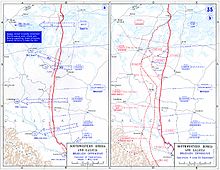| Second Brusilov offensive | |||||||||
|---|---|---|---|---|---|---|---|---|---|
| Part of the Brusilov offensive of Eastern front | |||||||||
 First - Forth Brusilov offensives (May–September 1916) | |||||||||
| |||||||||
| Belligerents | |||||||||
|
|
| ||||||||
| Commanders and leaders | |||||||||
|
|
| ||||||||
| Strength | |||||||||
| 933,336[9] | 580,048[10] | ||||||||
| Casualties and losses | |||||||||
| 312,000 casualties[11] | 127,000 captured[11] | ||||||||
The Second Brusilov offensive took place in July–August 1916 on the Eastern Front during the First World War. As a result of the First Brusilov offensive in May–June 1916, the Imperial Russian army defeated the Austro-Hungarian troops and captured a large number of prisoners (up to 50% of the soldiers of the Austro-Hungarian army were of Slavic origin and did not want to fight against the Russian Empire). But Imperial German army came to the aid of its ally. In July 1916, all Austro-Hungarian troops were subordinated to Paul von Hindenburg and Erich Ludendorff and Hindenburg became commander-in-chief of the entire Eastern Front. The weakest sections of the Austro-Hungarian front were reinforced by German divisions, and most importantly, in the direction of the impending main attack of the Russian Southwestern Front (on Kovel), the defense was mainly occupied by German troops. The offensive was ambiguous, in central Galicia and on the Dniester, the Russians achieved decisive results, but the attacks on Kovel failed. At the same time, the Russians practically stopped losing soldiers captured and killed, but the central powers suffered losses mostly irretrievably.[12]
- ^ Despite the huge advance, by the autumn of 1916 the Russians had lost their offensive potential and the usual bloody battles for a small territory ensued
- ^ The Russians were unable to take Kovel, however, they had a number of major successes on other fronts; they were able to force the entire enemy group to retreat beyond the Stokhid River
- ^ Олейников 2016, p. 162-163.
- ^ Людендорф; указ соч.,С. 224
- ^ a b c Олейников 2016, p. 163.
- ^ a b c d e f Олейников 2016, p. 164.
- ^ The Russians defeated Russians at Setlec, taking 8,000 prisoners there, but further advance proved impossible due to the impact of the Carpathian corps on the flank of the Russian army
- ^ a b Олейников 2016, p. 165.
- ^ Nelipovich 2006, p. 25.
- ^ Nelipovich 2006, p. 26.
- ^ a b Nelipovich 2006, p. 30.
- ^ Nelipovich 2006, p. 41.
